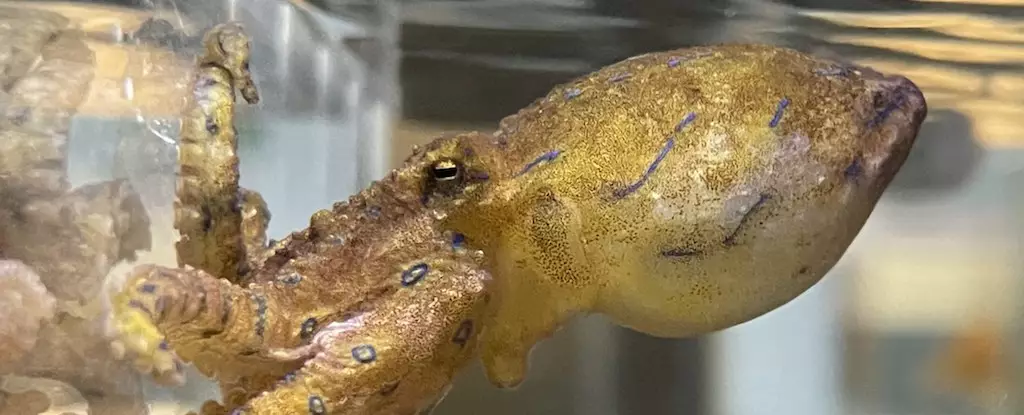The blue-lined octopus, scientifically known as Hapalochlaena fasciata, packs a lethal punch despite its modest size, usually only a few centimeters long. This tiny creature is a paradox, combining striking beauty with deadly capabilities. Found primarily in the Pacific and Indian Oceans, it boldly flaunts its vibrant, blue rings as both a warning and a lure. Yet, therein lies a critical examination of the delicate balance between allure and threat. The octopus serves as a stark reminder of nature’s capacity for danger, even in the most unsuspecting packages.
The Toxic Toolbox: Tetrodotoxin and Its Implications
The blue-lined octopus is armed with tetrodotoxin (TTX), a neurotoxin that can incapacitate prey and deter predators. Just a microgram of this toxin can potentially kill a human, making effective understanding and management of these creatures paramount. While other marine animals utilize various defense mechanisms, the blue-lined octopus employs an exceptionally efficient yet gruesome form: paralyzing its opponents before making its next move.
This brings us to a vital point in the discussion about the blue-lined octopus. The use of TTX raises critical ethical concerns regarding human interaction with marine ecosystems. Should we really risk our lives to observe these enigmatic creatures in their habitat? Understanding the nuances of such toxic dynamics is essential for our collective safety and the preservation of marine biodiversity.
Size Disparity: An Evolutionary Trap
In the realm of blue-lined octopuses, sexual dimorphism offers both a survival strategy and a potential death sentence. Males are significantly smaller than females, leading to what could be described as a tragic advantage for the latter. Once the mating season approaches, male blue-lined octopuses head into a perilous game of survival where their minute size makes them targets for cannibalistic females.
A recent study revealing the mating methods of these octopuses offers insight into this evolutionary juggling act. Males, in their desperation, resort to a dangerous tactic: they attempt to incapacitate females by delivering a precise bite near the aorta, injecting TTX to paralyze them temporarily. In essence, the very act of procreation doubles as an act of survival, throwing light on nature’s intricate web of relationships where love is entangled with assassination.
Breathing Patterns and the Dance of Deadly Chemistry
What does a mating ritual look like when one partner is on the brink of becoming a victim? Researchers have closely studied this phenomenon, discovering distinct breathing patterns during mating. Observations reveal that while males amp up their breathing rates, preparing for copulation, females experience a drastic drop in their respiratory activity. The moment of mating can lead to a complete cessation of breath, suggesting that the females enter a state reminiscent of TTX-induced paralysis.
Furthermore, this critical moment is not simply a fraught encounter; it serves as a complex interplay of evolutionary strategy and survival instinct. After being bitten, females show physical evidence at the site of impact, suggesting they cooperate with a mechanism that relies on high levels of resistance to TTX. Rather than succumbing to their mating partners, they emerge, albeit shaken, possessing a counter-strategy that raises questions about our understanding of chemical interactions in the natural world.
Coevolution: The Arms Race Beneath the Waves
The interaction between male and female blue-lined octopuses presents a fascinating example of coevolution. Males have not only developed a method of survival that involves TTX but have also increased the size of their salivary glands, possibly in response to their predatory females. This co-evolutionary arms race is not just a survival mechanism; it’s a telling reflection of nature’s harsh reality where aggressive mating behaviors and deadly defenses manifest in tragic harmony.
Moreover, the male’s adaptability highlights a broader conversation about informed conservation. With the persistent issues of habitat degradation and climate change threatening marine life, comprehending such complex relationships could inform policies designed to protect these animals while promoting a deeper appreciation of their roles within the ecosystem.
The blue-lined octopus encapsulates the multiple layers of life and death intricately woven into the fabric of marine biology. From its breathtaking beauty to its lethal capabilities, this tiny assassin serves as a poignant reminder of the complexities of nature. Engaging with and understanding such creatures could alter the way we value marine ecosystems, pushing us towards more sustainable practices that respect both the allure and the danger inherent in the natural world. The reality is not just appreciation but recognition of our responsibility towards preserving these intricate systems before they vanish beneath the tide.

